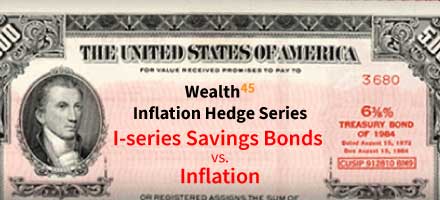Arguably, the simplest of all investments—U.S. Savings Bonds—may be the best current hedge against inflation available.
As discussed in my prior post, Are TIPS a Good Investment, TIPS are nearly the perfect inflation hedge. Your return is fully protected from inflation since the bonds yield is adjusted based on actual inflation experienced. You receive a fixed, inflation-adjusted return, over the life of the bond.
But, the problem with TIPS, is they currently trade at a negative yield. Instead of providing a fixed return above future inflation—they trade at a fixed return below inflation—locking in a negative real (inflation-adjusted) return.
For example, at the latest auction of 5-year TIPS in April 2021, the median coupon yield equaled -1.69%.[i] Locking in a significant inflation-adjusted loss for bond holders.
Series I Savings Bond to the Rescue
This is where the old-fashion Savings Bonds comes in.
Currently, the composite rate for I bonds issued from May 2021 through October 2021, is 3.54%.[ii]
For an investment guaranteed by the United States Government, I don’t think you will find a better deal.
Compare this with current Treasury yields of under 1% for a 5-year Note and around 2.3% for a 30-year Bond.
How do Savings Bonds Work?
The I-series Savings Bond return is “based upon a combination of a fixed rate of return and a variable semiannual rate.”[iii]
Like TIPS, the variable semiannual rate in indexed to inflations. But the fixed rate is set by the Treasury and has ranged from 0% to 0.5% over the past 10 years.
Hence, the fixed rate is very low, but at least it is not negative!
Worst case, at a 0% fixed rate, you at least maintain your inflation-adjusted purchasing power—far more than can be said for TIPS today.
To quote the Treasury website:
“An I bond earns interest monthly from the first day of the month in the issue date. The interest accrues (is added to the bond) until the bond reaches 30 years or you cash the bond, whichever comes first.
The interest is compounded semiannually. Every six months from the bond’s issue date, all interest the bond has earned in previous months is in the bond’s new principal value. Interest is earned on the new principal for the next six months.”
The Catch
So, what’s the catch? Sounds too good to be true.
Yes, there are certainly disadvantages and limitations to be aware of.
Depending on your situation, these limitations may dim the attractiveness of using I-series Savings Bonds to hedge inflation.
- Annual purchase limits—each person is limited to purchasing $10,000 in I-series Savings Bonds each year (plus the option to purchase an additional $5,000 using your tax refund).
- Low real returns—although the current yield is enticing, the inflation-adjusted return is very low.
- Only purchase directly from the Treasury—these are not marketable securities. You can only buy and redeem savings bonds via the TreasuryDirect website (although paper savings bonds can be cashed at some financial institutions).[iv]
- No liquidity for the first year—you must hold savings bonds for at least 12 months.
- Penalty for selling before 5 years—redeeming the bonds between 1-year and 5-years after purchase, results in a penalty of three months of interest payments.
Conclusion
If you are considering buying TIPS, I would strongly consider buying the I-series Savings Bonds instead. You give up some short-term liquidity, but at least for now, the yield is far superior.
Just understand that you are giving up any hope for a meaningful real return. The real return is fixed a zero, but at least it is not negative.
[i] https://www.treasurydirect.gov/instit/annceresult/press/preanre/2021/R_20210422_3.pdf
[ii] https://www.treasurydirect.gov/indiv/research/indepth/ibonds/res_ibonds_iratesandterms.htm
[iii] https://www.treasurydirect.gov/indiv/research/indepth/ibonds/res_ibonds_iratesandterms.htm
[iv] https://www.treasurydirect.gov/indiv/research/indepth/ibonds/res_ibonds_iredeem.htm



1 Comments
[…] on May 2021, I initially discussed the surprising merits of the humble U.S. Savings Bond in my post SAVINGS BONDS – INFLATION HEDGE SERIES. At that time, the Series I bond was paying 3.54%. Today, Series I Savings Bonds yield […]
Reply